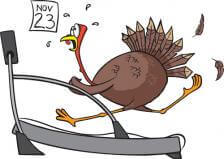
Nutrition Diva listener Brian wants to know:
"Do the benefits of fermented vegetables such as sauerkraut and kimchi outweigh the risk of getting stomach cancer. I understand that Koreans, who eat a lot of kimchi, also have the highest rates of stomach cancer. So, I'm wondering whether increasing our consumption of these products in order to help the beneficial bacteria in our guts is worth the risk."
Brian is right: People in Asian countries, where fermented vegetables make up a large part of the diet, do have higher rates of stomach cancer than elsewhere in the world.
What are the main risk factors for stomach cancer?
Fifty years ago, stomach cancer was the most common type of cancer diagnosed worldwide. And the good news is that the global incidence of stomach cancer has declined significantly over the last decades. This is due in part to declines in smoking, which is a significant risk factor for stomach cancer. It's also due to better detection and treatment of h. Pylori, a bacterium that commonly infects the digestive tract and can cause stomach ulcers as well as stomach cancer. H. Pylori is readily eradicated by antibiotic therapy and now that we know to look for it, and how to get rid of it, ulcers and stomach cancer are far less common.
What's the link between fermented veggies and cancer?
However, the incidence of stomach cancer remains high in Korea and elsewhere in Asia. And, believe it or not, the very high consumption of fermented vegetables is thought to be one contributing factor. This is a little confusing because eating more vegetables is a good way to reduce your risk of cancer. And, as Brian points out, fermented vegetables also contain probiotic bacteria, which foster a healthy gut.
At the same time, fermented vegetables contain nitrosamines. These compounds, which are by-products of the fermentation process, can have carcinogenic effects. Here in the West, the primary source of dietary nitrosamines are cured and processed meats. In Korea, where total nitrosamine intake is much higher, the primary dietary sources are smoked or salted fish and fermented vegetables.
The traditional Korean diet is also much higher in sodium than the typical Western diet (which is not exactly low in sodium), and this may be another contributing factor to the high rates of stomach cancer. Sodium, in high amounts, can irritate the lining of the stomach and perhaps make it more vulnerable to the carcinogenic effects of nitrosamines.
Another thing to keep in mind is that the traditional Korean diet, while high in fermented and pickled vegetables, may be quite low in fresh vegetables. The nutrients in fresh vegetables, especially vitamin C, can neutralize the nitrosamines in the digestive tract. And...
Keep reading on Quick and Dirty Tips





















 Research shows that when we use smaller plates, we serve ourselves smaller portions, consume fewer calories, but feel just as satisfied as we do after eating more calories off of larger plates. Now consider that the average size of dinner plates has gone from 9 to 13 inches over the last 30 years and our
Research shows that when we use smaller plates, we serve ourselves smaller portions, consume fewer calories, but feel just as satisfied as we do after eating more calories off of larger plates. Now consider that the average size of dinner plates has gone from 9 to 13 inches over the last 30 years and our 






